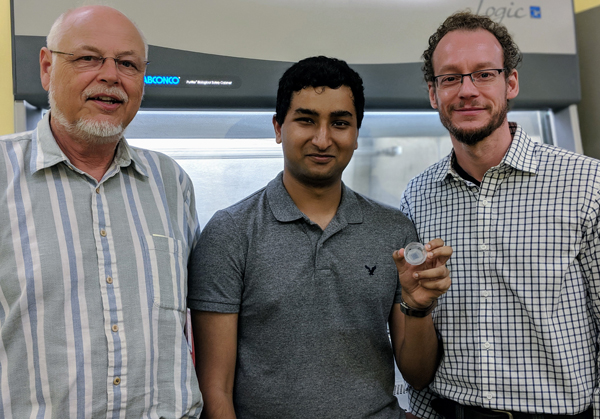A new approach for finding Alzheimer's treatments
Researchers from McMaster University have found a new way to look for Alzheimer’s treatments, a disease that affects over 747,000 Canadians.
By Colleen MacPhersonResearchers (left to right) Adree Khondker, Adam Hitchcock, and Maikel Rheinstädter are working on new tools to study Alzheimer's disease
Considering what little progress has been made finding drugs to treat Alzheimer’s disease, Maikel Rheinstädter decided to come at the problem from a totally different angle—perhaps the solution lay not with the peptide clusters known as senile plaques typically found in the brains of Alzheimer’s patients, but with the surrounding brain tissue that allowed those plaques to form in the first place.
It was a novel approach that paid off for Rheinstädter and his team of researchers from McMaster University who used the Canadian Light Source in Saskatoon as part of a study of the effect various compounds have on membranes in brain tissue and the possible impact on plaque formation.
“Alzheimer’s disease has interested me for a long time,” said Rheinstädter, a professor in the Department of Physics and Astronomy and the Origins Institute at McMaster. “It is something almost every Canadian will be affected by in their lives.”

The problem is that peptides, which always exist in everyone’s brain, start to cluster into plaques that are toxic to surrounding tissue at some point and cause Alzheimer’s, “and we don’t understand why and what exactly makes them cluster together.” Age seems to play an important role in this process and our body and body tissues change significantly when we get older.
So Rheinstädter reimagined the clustering process, substituting leaves floating on a puddle for peptides in the brain. “Eventually the leaves end up forming little islands on top of the water but it’s not because the leaves are attracted to each other. It’s because of the properties of the water.”
He wondered if there were compounds that would affect brain tissue the way a drop of dish soap disrupts the surface tension of water. He theorized an analogous change in human brain membranes could prevent plaque formation or even break apart existing peptide clusters.
“We decided to start with molecules often speculated to have an effect on Alzheimer’s disease,” he said, adding that scientific evidence that the molecules work is currently lacking. Working with colleagues from McMaster’s Department of Chemistry and Chemical Biology, Rheinstädter selected three compounds to study—melatonin, acetylsalicylic acid (ASA) and curcumin, a yellow plant-produced chemical that gives turmeric its colour.
To test Rheinstädter’s theory that surrounding membranes are important to plaque formation, the researchers developed a synthetic membrane to use in place of human brain tissue. “Brain tissue has some negative charge that may also play a role in attracting peptides so we even included that. We have a good mimic of brain tissue.”
The compounds of interest were introduced into two systems—one synthetic membrane without peptide clusters and a second with clusters already in place—and the effect each compound had on the membranes and peptides was measured by a range of techniques, including microscopy at the CLS spectromicroscopy beamline.
Adding melatonin resulted in no change to the peptide clusters while ASA led to larger cluster formations.
However, curcumin not only reduced the size of existing clusters but also prevented clusters from forming.
Research team member Dr. Adam Hitchcock, a McMaster chemistry professor, said the CLS “is arguably among the best tools to use in this particular area” because it allows direct visualization of peptides in the synthetic membrane.
“What we’ve created with the synthetic membranes is Alzheimer’s on a chip which means we can test drugs on that chip before clinic trials,” said Rheinstädter. “We need drugs that are thoroughly tested so we can weed out those that don’t do anything before we use them on people.”
The research group has one year from the publication date of their results to patent their discovery, which they intend to do, he said. It can then be made available to drug companies to test the various components of existing or future drugs.
“It was time to take a new approach,” said Rheinstädter. “Alzheimer’s is a disease like any other. We just need to understand it better and we need a drug to treat it, but if a drug does not prove effective in our system, I would not take that pill.”
Khondker, Adree, Richard J. Alsop, Sebastian Himbert, Jennifer Tang, An-Chang Shi, Adam P. Hitchcock, and Maikel C. Rheinstädter. "Membrane-Modulating Drugs can Affect the Size of Amyloid-β 25–35 Aggregates in Anionic Membranes." Scientific reports 8, no. 1 (2018): 12367.
To arrange an interview, contact:
Victoria Martinez
Communications Coordinator
Canadian Light Source
306-657-3771
victoria.martinez@lightsource.ca
